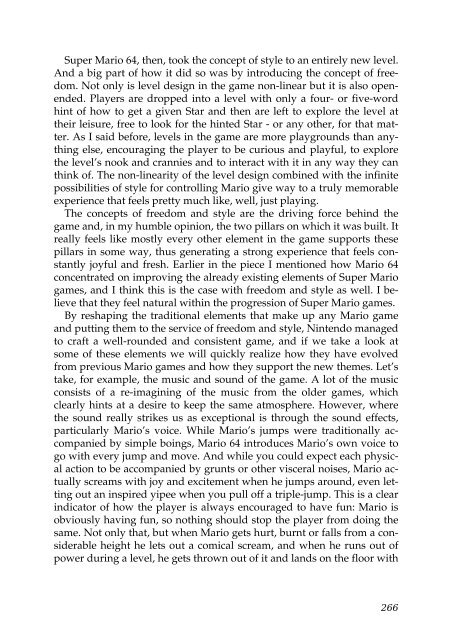Well Played 2.0: Video Games, Value and Meaning - OpenLibra
Well Played 2.0: Video Games, Value and Meaning - OpenLibra
Well Played 2.0: Video Games, Value and Meaning - OpenLibra
You also want an ePaper? Increase the reach of your titles
YUMPU automatically turns print PDFs into web optimized ePapers that Google loves.
Super Mario 64, then, took the concept of style to an entirely new level.<br />
And a big part of how it did so was by introducing the concept of freedom.<br />
Not only is level design in the game non-linear but it is also openended.<br />
Players are dropped into a level with only a four- or five-word<br />
hint of how to get a given Star <strong>and</strong> then are left to explore the level at<br />
their leisure, free to look for the hinted Star - or any other, for that matter.<br />
As I said before, levels in the game are more playgrounds than anything<br />
else, encouraging the player to be curious <strong>and</strong> playful, to explore<br />
the level’s nook <strong>and</strong> crannies <strong>and</strong> to interact with it in any way they can<br />
think of. The non-linearity of the level design combined with the infinite<br />
possibilities of style for controlling Mario give way to a truly memorable<br />
experience that feels pretty much like, well, just playing.<br />
The concepts of freedom <strong>and</strong> style are the driving force behind the<br />
game <strong>and</strong>, in my humble opinion, the two pillars on which it was built. It<br />
really feels like mostly every other element in the game supports these<br />
pillars in some way, thus generating a strong experience that feels constantly<br />
joyful <strong>and</strong> fresh. Earlier in the piece I mentioned how Mario 64<br />
concentrated on improving the already existing elements of Super Mario<br />
games, <strong>and</strong> I think this is the case with freedom <strong>and</strong> style as well. I believe<br />
that they feel natural within the progression of Super Mario games.<br />
By reshaping the traditional elements that make up any Mario game<br />
<strong>and</strong> putting them to the service of freedom <strong>and</strong> style, Nintendo managed<br />
to craft a well-rounded <strong>and</strong> consistent game, <strong>and</strong> if we take a look at<br />
some of these elements we will quickly realize how they have evolved<br />
from previous Mario games <strong>and</strong> how they support the new themes. Let’s<br />
take, for example, the music <strong>and</strong> sound of the game. A lot of the music<br />
consists of a re-imagining of the music from the older games, which<br />
clearly hints at a desire to keep the same atmosphere. However, where<br />
the sound really strikes us as exceptional is through the sound effects,<br />
particularly Mario’s voice. While Mario’s jumps were traditionally accompanied<br />
by simple boings, Mario 64 introduces Mario’s own voice to<br />
go with every jump <strong>and</strong> move. And while you could expect each physical<br />
action to be accompanied by grunts or other visceral noises, Mario actually<br />
screams with joy <strong>and</strong> excitement when he jumps around, even letting<br />
out an inspired yipee when you pull off a triple-jump. This is a clear<br />
indicator of how the player is always encouraged to have fun: Mario is<br />
obviously having fun, so nothing should stop the player from doing the<br />
same. Not only that, but when Mario gets hurt, burnt or falls from a considerable<br />
height he lets out a comical scream, <strong>and</strong> when he runs out of<br />
power during a level, he gets thrown out of it <strong>and</strong> l<strong>and</strong>s on the floor with<br />
266

















